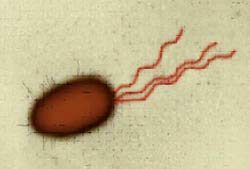Microbots Designed to Swim Like Bacteria

Tiny microrobots are under development at Monash University in Australia. A remarkable micromotor will allow them to swim like an E. coli bacterium, which uses its flagella to move around.
A flagellum is a long, structure composed of microtubules; bacteria use them in a whip-like motion to move around.
James Friend's goal is to build a device no wider than 250 microns—that's the width of two human hairs—that would be capable of swimming through the human body.
He and his team have already built a linear motor the size of a salt crystal. With a $300,000 grant from the Australian Research Council, Friend believes that his team will be able to reduce the motor to the necessary size within three years.
According to Friend, the main difference between the microrobot motor and a conventional electromagnetic type is that the latter spins much faster but has much less twisting force. In an email interview with Technovelgy.com, he remarked:
"The swimming robot idea in and of itself has indeed been around a long time—since at least the 1950's anyway, and our motor is of a scale and has the performance characteristics needed to actually make this sort of thing possible. We're using ultrasonic motor technology here, which offer higher torques at lower speeds."
Friend said, "We've operating larger mm-sized prototypes of the motor, and have a fairly good handle on the analysis, which turns out to be quite complicated for twisted-beamstructures." (See a design for the prototype microrobot.)
The micromotor that Friend and his team have designed for their propulsion system should be smaller overall than a similar microrobot propulsion system described in November by Moshe Shoham (see Propulsion System for 'Fantastic Voyage' Robot). Friend points out that his team has a "motor suitable for his [Shoham's] or our propulsion system that is far smaller than the technology he's [Shoham's] wanting to use."
Sign up for the Live Science daily newsletter now
Get the world’s most fascinating discoveries delivered straight to your inbox.
Ultimately, tiny microrobots would give surgeons the ability to avoid traumatic and risky procedures in some cases. A remotely-controlled microrobot would extend a physician's ability to diagnose and treat patients in a minimally invasive way.
Researchers at UCLA have gone in a different direction for a power source for a microrobot; click on Musclebot: Microrobot with a Heart for an alternative to micromotors. If you can't quite picture cell repair by medical nanorobots, click here for a graphic view.
Other sources for this story include this article and this Monash University press release.
(This Science Fiction in the News story used with permission from Technovelgy.com —where science meets fiction.)









